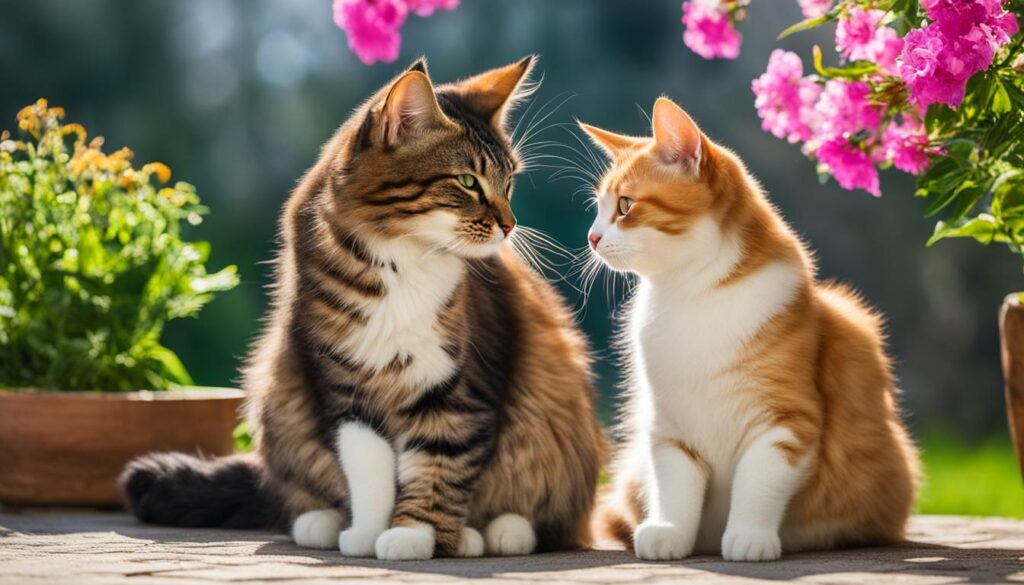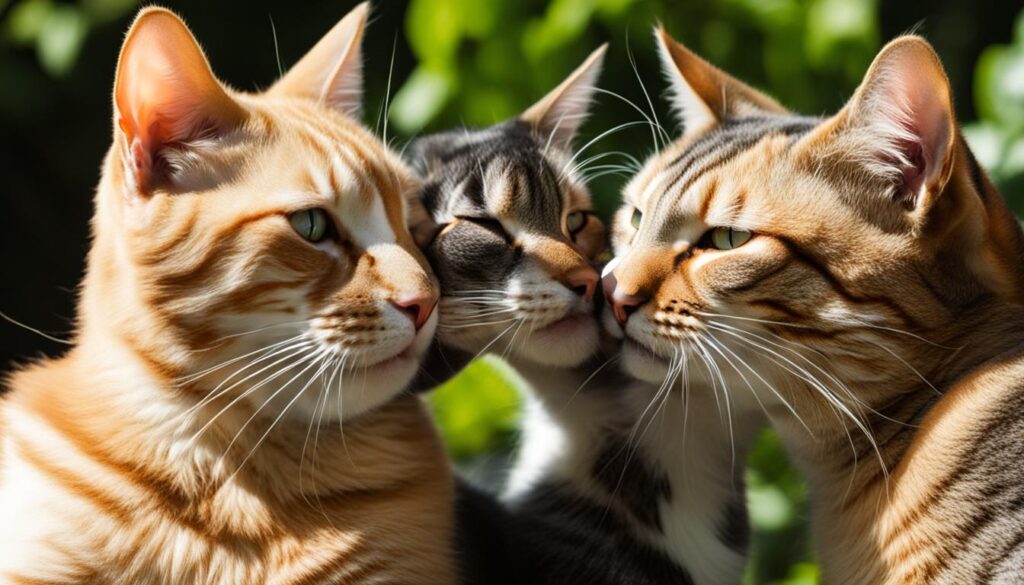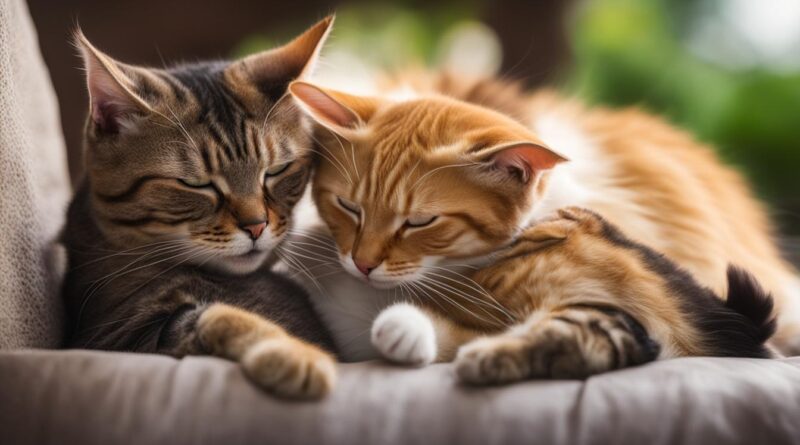Understanding Why Cats Lick Each Other Explained
Have you ever wondered why cats lick each other? It’s not just a simple grooming behavior; there are actually several reasons behind this fascinating feline habit. Understanding why cats engage in social grooming can provide insights into their behavior and help strengthen the bond between you and your furry friend.
Social grooming, also known as allogrooming, is a common aspect of cat behavior. Cats groom each other for various reasons, including communication, social bonding, survival instincts, and grooming hard-to-reach areas. This behavior is not limited to domestic cats but is observed in wild cat populations as well.
Key Takeaways:
- Cats groom each other for communication, social bonding, and survival instincts.
- Allogrooming helps cats groom hard-to-reach areas.
- Maternal allogrooming is essential for newborn kittens’ development and hygiene.
- Excessive grooming may indicate underlying health issues.
- Allogrooming is a normal and beneficial behavior for cats.
The Reasons Behind Allogrooming in Cats
Allogrooming, which involves cats grooming each other, serves various purposes that contribute to their overall well-being. Let’s explore the reasons behind this intriguing feline behavior.
Communication and Social Bonding
One of the primary reasons cats engage in allogrooming is for communication and social bonding. When cats groom each other, they exchange scents through their saliva. This exchange of pheromones helps them establish a sense of familiarity and belonging within their social group. Allogrooming is commonly observed between cats that share a strong bond, such as littermates or cats that have been together for a long time.
Promoting Survival and Hygiene
Aside from social bonding, cats also engage in allogrooming to promote survival and hygiene. By grooming each other, they help remove parasites, such as fleas and ticks, from their fur. Additionally, cats can reach and groom areas of their bodies that are difficult for them to clean effectively on their own, such as the back of the neck and ears.
Showcasing Affection and Trust
Allogrooming is also a way for cats to express affection and demonstrate trust towards each other. By engaging in this behavior, cats showcase their willingness to care for and nurture their companions. It’s a heartwarming display of their social connection and mutual bond.

Maintaining vigilance over excessive grooming is crucial. While allogrooming is a natural behavior, excessive grooming can indicate underlying skin inflammation or itchiness. If you notice your cat excessively grooming certain areas or displaying signs of discomfort, it’s essential to consult a veterinarian for proper evaluation and treatment.
In the next section, we’ll delve into the role of allogrooming in cat colony dynamics, shedding light on the fascinating social interactions within cat communities.
| Reasons Behind Allogrooming in Cats: |
|---|
| Communication and Social Bonding |
| Promoting Survival and Hygiene |
| Showcasing Affection and Trust |
The Role of Allogrooming in Cat Colony Dynamics
Allogrooming plays a crucial role in the dynamics of cat colonies. In outdoor colonies, cats engage in social grooming as a means of survival, ensuring the removal of parasites and the maintenance of good hygiene. This grooming ritual also serves as a form of communication and bonding within the colony, fostering social connections and relationships.
Preferred individuals within the colony establish special bonds and engage in allogrooming, which is typically reserved for close family members or cats that have been together for an extended period. Through this grooming behavior, cats convey trust, affection, and a sense of belonging.
In multi-cat households, allogrooming can contribute to the establishment and maintenance of hierarchy, although it does not always indicate dominance. Cats may groom lower-ranking cats to calm themselves and prevent conflicts, promoting harmony within the group. Allogrooming is a complex behavior that intricately weaves into the social fabric of cat colonies, enhancing their social life and dynamics.
To better understand the importance of allogrooming in cat colony dynamics, let’s take a look at the following table:
| Benefits of Allogrooming in Cat Colonies |
|---|
| Parasite removal |
| Maintenance of good hygiene |
| Enhanced communication and bonding |
| Establishment and maintenance of hierarchy |
| Promotion of harmony within the group |
The Benefits of Allogrooming in Cat Colonies
- Parasite removal: Cats groom each other to help eliminate parasites, ensuring the well-being and health of the colony.
- Maintenance of good hygiene: Allogrooming aids in keeping the fur clean and free from dirt or debris, improving overall hygiene.
- Enhanced communication and bonding: Through allogrooming, cats communicate with one another and strengthen their social bonds within the colony.
- Establishment and maintenance of hierarchy: Allogrooming can contribute to the establishment and maintenance of social hierarchy within the cat colony, enabling a harmonious group dynamic.
- Promotion of harmony within the group: By grooming lower-ranking cats, higher-ranking cats can help calm potential conflicts and foster a sense of unity in the colony.
This table and list illustrate the various benefits of allogrooming in cat colonies. These grooming rituals play a crucial role in the social dynamics and well-being of cat communities, highlighting the importance of social grooming in cats.

Maternal Allogrooming and Its Importance
Maternal allogrooming plays a vital role in the development and well-being of newborn kittens. Mother cats instinctively groom their kittens immediately after birth to stimulate them to eliminate waste and clean them up. This grooming behavior continues as the kittens grow and learn to groom themselves.
Maternal allogrooming serves multiple purposes and has significant benefits for both the mother cat and her kittens. One of the primary reasons for this behavior is to maintain hygiene. By grooming their kittens, mother cats help to keep their fur clean and free from debris.
Furthermore, maternal allogrooming supports bonding between the mother cat and her kittens. Through this grooming activity, the mother cat provides comfort, warmth, and security to her young ones. It helps the kittens feel loved and cared for, establishing a strong maternal bond that is crucial for their emotional and social development.
Maternal allogrooming also plays a vital role in teaching kittens how to groom themselves. By observing and imitating their mother’s grooming behavior, kittens learn the techniques and habits necessary to maintain their own hygiene as they grow older.
This early grooming experience serves as the foundation for the kittens’ grooming habits later in life. It establishes a lifelong grooming routine that contributes to their overall well-being and helps them maintain healthy fur, skin, and physical condition.
Overall, maternal allogrooming is a natural and essential behavior for mother cats and their kittens. It not only ensures hygiene but also fosters bonding, provides comfort, and teaches crucial grooming skills. This nurturing behavior lays the groundwork for the kittens’ overall development, helping them grow into healthy and well-adjusted adult cats.
The Misconceptions and Signs of Abnormal Grooming
When it comes to cat grooming, there are some common misconceptions that need to be addressed. One of these misconceptions is the belief that a cat’s saliva has healing powers. However, it’s important to understand that a cat’s saliva can actually contain harmful bacteria. Therefore, it’s crucial to discourage cats from licking wounds as it can increase the risk of infection.
Cats are known for their meticulous grooming habits. However, excessive grooming can be a sign of underlying issues. If you notice that your cat is grooming excessively, it may indicate skin inflammation or itchiness caused by parasites or allergies. Monitoring changes in grooming behavior is essential to ensure the well-being of your feline friend.
Another interesting behavior to pay attention to is the reaction of other cats in the household. They may pick up on changes in grooming behavior and respond by increasing their own grooming or spending more time in close proximity to the affected cat. This can provide valuable insight into the abnormal grooming and help identify any potential health concerns.
Understanding your cat’s baseline grooming behavior is crucial. If you notice any significant changes or abnormal grooming patterns, it’s advisable to consult a veterinarian. They can provide professional advice and assistance in determining the cause of the behavior and addressing any underlying health issues.
Common Signs of Abnormal Grooming:
- Excessive grooming
- Intense scratching or licking of specific areas
- Hair loss or bald patches
- Skin redness, inflammation, or lesions
- Presence of fleas or ticks
- Changes in appetite or behavior
Recognizing these signs can help you identify potential problems early on and provide the necessary care and attention to your cat’s grooming needs.
“Understanding the misconceptions surrounding cat grooming and being aware of abnormal grooming signs empowers cat owners to proactively maintain their furry companions’ well-being.”
– Dr. Lisa Miller, Feline Behavior Specialist
Here is a table summarizing the misconceptions and signs of abnormal grooming:
| Misconceptions | Signs of Abnormal Grooming |
|---|---|
| A cat’s saliva has healing powers | Excessive grooming |
| Intense scratching or licking of specific areas | |
| Hair loss or bald patches | |
| Skin redness, inflammation, or lesions | |
| Presence of fleas or ticks | |
| Changes in appetite or behavior |
By dispelling misconceptions and being knowledgeable about abnormal grooming signs, cat owners can proactively ensure the health and well-being of their feline companions.
Conclusion
Cats engage in social grooming known as allogrooming to communicate, show affection, bond, and maintain hygiene. This behavior plays a role in establishing hierarchy within cat colonies, but it does not necessarily indicate dominance. Maternal allogrooming is crucial for the development of newborn kittens and serves as a way for mother cats to bond with their offspring.
Monitoring excessive grooming or changes in grooming behavior is important, as it can be a sign of underlying health issues. Allogrooming contributes to the social dynamics and overall well-being of cats. It is a normal and beneficial behavior that helps cats form and maintain relationships with other felines.
In summary, cat grooming behavior, including social grooming and feline grooming habits, is a natural aspect of their instincts. Cats have evolved to lick each other for various reasons, including communication, bonding, and hygiene. Understanding these reasons allows us to better appreciate and care for our feline companions.
FAQ
Why do cats groom each other?
Cats groom each other, known as allogrooming, for various reasons including communication, social bonding, survival instincts, and grooming hard-to-reach areas.
What is the purpose of allogrooming in cats?
Allogrooming serves multiple purposes including communication, social bonding, survival instincts, and grooming hard-to-reach areas.
Do cats groom each other to establish dominance?
Allogrooming can establish hierarchy in cat colonies, but it doesn’t necessarily indicate dominance. Cats may groom lower-ranking cats to calm themselves and avoid conflicts.
Why is maternal allogrooming important?
Maternal allogrooming is essential for newborn kittens’ development and hygiene. It helps stimulate elimination, clean them up, bond with their mother, and teaches them to groom.
Can excessive grooming in cats indicate health issues?
Yes, excessive grooming or changes in grooming behavior should be monitored as it may indicate skin inflammation or itchiness due to parasites or allergies. It’s important to consult a veterinarian if there are any concerns.
Are there any misconceptions about cat grooming?
Yes, a common misconception is that a cat’s saliva has healing powers. In reality, it can contain harmful bacteria. Cats also groom themselves extensively, but excessive grooming can indicate underlying health issues and should be monitored.


